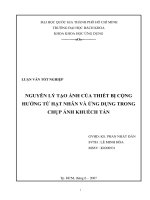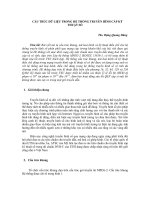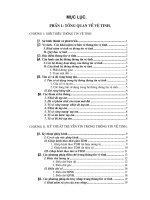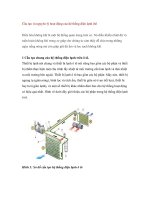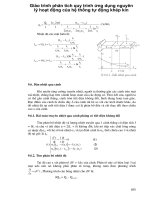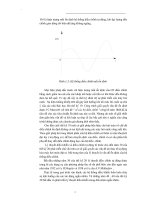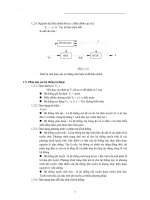Nguyên lý tạo ảnh của hệ thống chụp X quang kỹ thuật số
Bạn đang xem bản rút gọn của tài liệu. Xem và tải ngay bản đầy đủ của tài liệu tại đây (1.04 MB, 13 trang )
Digital Radiography – Bushberg Chapter 11
Adjuncts to Radiology – Bushberg Chapter 12
Diagnostic Radiology Imaging Physics Course
13 and 20 January 2005
Take Away: Five Things You should be able
to Explain after the DR/Adjuncts Lecture
Digital Radiography – Chapter 11
Adjuncts to Radiology – Chapter 12
¬
¬
¬
Brent K. Stewart, PhD, DABMP
Professor, Radiology and Medical Education
Director, Diagnostic Physics
¬
¬
a copy of this lecture may be found at:
/>
Brent K. Stewart, PhD, DABMP
The various types of detectors used in digital imaging
(e.g., scintillators, photoconductors, etc.)
The differences between the various technologies used
for digital radiography (e.g., CR, indirect and direct DR)
Benefits of each type (e.g., resolution, dose efficiency)
Why digital image correction and processing are
necessary or useful and how they are executed
The various types of adjuncts to radiology (e.g., DSA or
dualdual-energy imaging), what issue they are trying to
resolve, mechanism exploited and end result
1
Brent K. Stewart, PhD, DABMP
Digital Representation of Data (1)
¬
¬
¬
¬
Digital Representation of Data (2)
Bits, Bytes and Words
¬
Smallest unit of storage capacity = 1 bit (b
(binary digit
digit:: 1 or 0)
Bits grouped into bytes: 8 bits = byte
Word = 16, 32 or 64 bits, depending on the computer system
addressing architecture
¬
Digital Representation of Different Types of Data
¬
Storage of Positive Integers
¬
¬
Computer storage capacity is measured in:
¬
¬
¬
¬
kilobytes (kB) - 210 bytes = 1024 bytes ≈ a thousand bytes
megabytes (MB) - 220 bytes = 1024 kilobytes ≈ a million bytes
gigabytes (GB) - 230 bytes = 1024 megabytes ≈ a billion bytes
terabytes (TB) - 240 bytes = 1024 gigabytes ≈ a trillion bytes
¬
¬
¬
¬
¬
Brent K. Stewart, PhD, DABMP
Brent K. Stewart, PhD, DABMP
2
3
Alphanumeric text, integers, and nonnon-integer data
In general, n bits have 2n possible permutations and can
represent integers from 0 to 2n-1 (the range usually denoted with
square brackets):
n bits represents 2n values with range [0, 2n-1]
8 bits represents 28 = 256 values with range [0, 255]
10 bits represents 210 = 1024 values with range [0, 1023]
12 bits represents 212 = 4096 values with range [0, 4095]
16 bits represents 216 = 65,536 values with range [0, 65535]
Brent K. Stewart, PhD, DABMP
4
1
Digital Radiography – Bushberg Chapter 11
Adjuncts to Radiology – Bushberg Chapter 12
Diagnostic Radiology Imaging Physics Course
13 and 20 January 2005
Conversion of Analog Data to Digital Form
¬
¬
¬
Digital Storage of Images
The electronic measuring devices of medical scanners (e.g.,
transducers and detectors) produce analog signals
Analog to digital conversion (analog to digital converter – ADC)
ADCs characterized by
¬
¬
¬
¬
sampling rate or frequency (e.g., samples/sec – 1 MHz)
number of bits output per sample (e.g., 12 bits/sample = 1212-bit ADC)
¬
Usually stored as a 2D array
(matrix) of data, I(x,y): I(1,1),
I(2,1), … I(n,mI(n,m-1), I(n,m)
Each minute region of the
image is called a pixel (picture
element) represented by one
value (e.g., digital value, gray
level or Hounsfield unit)
Typical matrices:
¬
¬
¬
CT: 512x512x12 bits/pixel
CR: 1760x2140x10 bits/pixel
DR: 2048x2560x16 bits/pixel
c. f. Bushberg, et al., The Essential Physics of Medical Imaging,
Imaging, 2nd ed., p. 69.
Brent K. Stewart, PhD, DABMP
c.f. Huang, HK. Elements of Digital Radiology, p. 8.
5
Brent K. Stewart, PhD, DABMP
Detectors in Digital Imaging (1)
¬
¬
¬
¬
Detectors in Digital Imaging (2)
Gas and solidsolid-state detectors
Energy deposited to ee- through
Compton and photoelectric
interactions
Gas detectors – apply high
voltage across a chamber and
measuring the flow of eeproduced by ionization in the
gas (typically high Z gases like
Xenon: Z=54, KK-edge = 35
keV)
Were used in older CT units
SolidSolid-state materials
¬
SolidSolid-state detectors
¬
¬
¬
c.f. Bushberg, et al. The Essential Physics of
Medical Imaging, 2nd ed., p.32.
Brent K. Stewart, PhD, DABMP
¬
¬
Brent K. Stewart, PhD, DABMP
6
Electrons arranged in bands with conduction band usually empty
Scintillators – some deposited energy converted to visible light
Photoconductors – charge collected and measured directly
Photostimulable phosphors – energy stored in electron traps
c.f. Yaffe MJ and Rowlands JA. Phys. Med. Biol. 42 (1997), p. Elements
Elements of Digital Radiology, p. 10.
7
Brent K. Stewart, PhD, DABMP
8
2
Digital Radiography – Bushberg Chapter 11
Adjuncts to Radiology – Bushberg Chapter 12
Diagnostic Radiology Imaging Physics Course
13 and 20 January 2005
Detectors in Digital Imaging (3)
Periodic Table of the Elements
c.f. Yaffe MJ and Rowlands JA. Phys. Med. Biol. 42 (1997), p. Elements
Elements of Digital Radiology, p. 9.
Brent K. Stewart, PhD, DABMP
9
c.f. />
Computed Radiography (CR)
¬
¬
¬
¬
¬
¬
¬
¬
¬
¬
Imaging plate (IP) made of PSP is
exposed identically to SF
radiography in Bucky
IP in CR cassette taken to CR
reader where the IP is separated
from cassette
IP is transferred across a stage
with stepping motors and scanned
by a laser beam (~
(~700 nm) swept
across the IP by a rotating
polygonal mirror
Light emitted from the IP is
collected by a fiberfiber-optic bundle
and funneled into a photomultiplier
tube (PMT)
PMT converts VL into e- current
c.f. Bushberg, et al. The Essential Physics of Medical
Imaging, 2nd ed., p. 294.
c.f. Bushberg, et al. The Essential Physics of Medical
Imaging, 2nd ed., p. 295.
Brent K. Stewart, PhD, DABMP
10
Computed Radiography (CR) System (1)
Photostimulable phosphor (PSP)
Barium fluorohalide: 85%
BaFBr:Eu + 15% BaFI:Eu
e- from Eu2+ liberated through
absorption of xx-rays by PSP
Liberated e- fall from the
conduction band into ‘trapping
sites’ near FF-centers
By low energy laser light (700 nm)
stimulation the e- are rere-promoted
into the conduction band where
some recombine with the Eu3+
ions and emit a blueblue-green (400(400500 nm) visible light (VL)
Brent K. Stewart, PhD, DABMP
Brent K. Stewart, PhD, DABMP
11
Brent K. Stewart, PhD, DABMP
12
3
Digital Radiography – Bushberg Chapter 11
Adjuncts to Radiology – Bushberg Chapter 12
Diagnostic Radiology Imaging Physics Course
13 and 20 January 2005
Computed Radiography (CR) System (2)
¬
¬
¬
¬
¬
¬
Computed Radiography (CR) System (3)
Electronic signal output from PMT
input to an ADC
Digital output from ADC stored
Raster swept out by rotating
polygonal mirror and stage
stepping motors produces I(t) into
PMT which eventually translates
into the stored DV(x,y):
PMT ADC RAM
IP exposed to bright light to erase
any remaining trapped e- (~50%)
IP mechanically reinserted into
cassette ready for use
200µ
200µm and 100µ
100µm pixel size (14”x17”: 1780x2160 and
3560x4320, respectively)
¬
¬
¬
IP dynamic range = 104, about
100x that of SS-F (102)
Very wide latitude
flat contrast
Image processing required:
¬
¬
¬
¬
¬
Enhance contrast
SpatialSpatial-frequency filtering
CR’s wide latitude and image
processing capabilities produce
reasonable OD or DV for either
under or overexposed exams
Helps in portable radiography:
where the tight exposure limits of
S-F are hard to achieve
Underexposed
quantum
mottle and overexposed
unnecessary patient dose
c.f. Bushberg, et al. The Essential Physics of Medical
Imaging, 2nd ed., p. 294.
Brent K. Stewart, PhD, DABMP
c.f. Bushberg, et al. The Essential Physics of Medical
Imaging, 2nd ed., p. 296.
13
Brent K. Stewart, PhD, DABMP
ChargedCharged-Coupled Devices (CCD)
¬
¬
¬
¬
¬
¬
¬
¬
Indirect Flat Panel Detectors
Form images from visible light
Videocams & digital cameras
Each picture element (pixel) a
photosensitive ‘bucket’
After exposure, the elements
electronically readout via ‘shift‘shiftandand-read’ logic and digitized
Light focused using lenses or
fiberfiber-optics
¬
¬
¬
¬
Fluoroscopy (II)
Digital cineradiography (II)
Digital biopsy system
(phosphor screen)
¬
1K and 2K CCDs used
c.f. Bushberg, et al. The Essential Physics of Medical
Imaging, 2nd ed., pp. 298298-299.
Brent K. Stewart, PhD, DABMP
Brent K. Stewart, PhD, DABMP
14
15
Use an intensifying screen
(CsI) to generate VL photons
from an xx-ray exposure
Light photons absorbed by
individual array photodetectors
Each element of the array
(pixel) consists of transistor
(readout) electronics and a
photodetector area
The manufacture of these
arrays is similar to that used in
laptop screens: thinthin-film
transistors (TFT)
c.f. Bushberg, et al. The Essential Physics of Medical
Imaging, 2nd ed., p. 301.
Brent K. Stewart, PhD, DABMP
16
4
Digital Radiography – Bushberg Chapter 11
Adjuncts to Radiology – Bushberg Chapter 12
Diagnostic Radiology Imaging Physics Course
13 and 20 January 2005
ThinThin-Film Transistors (TFT)
¬
¬
¬
¬
Resolution and Fill Factor
After the exposure is complete
and the e- have been stored in
the photodetection area
(capacitor), rows in the TFT
are scanned, activating the
transistor gates
Transistor source (connected
to photodetector capacitors is
shunted through the drain to
associated charge amplifiers
Amplified signal from each
pixel then digitized and stored
X-ray VL e- ADC RAM
¬
¬
¬
¬
¬
¬
c.f. Bushberg, et al. The Essential Physics of Medical
Imaging, 2nd ed., p. 301.
Brent K. Stewart, PhD, DABMP
¬
¬
¬
¬
¬
Use a layer of photoconductive
material (e.g., -Se)
Se) atop a TFT
array
e- released in the detector layer
from xx-ray interactions used to
form the image directly
X-ray e- TFT
ADC RAM
High degree of e- directionality
through application of E field
Photoconductive material can be
made thick w/o degradation of
spatial resolution
Photoconductive materials
¬
¬
c.f. Bushberg, et al. The Essential Physics of Medical Imaging, 2nd ed., p. 303.
17
Direct Flat Panel Detectors
¬
Dimension of detector element largely determines spatial resolution
resolution
200µ
200µm and 100µ
100µm pixel size typical
For dimension of ‘a’ mm - Nyquist frequency: FN = 1/2a
If a = 100µ
FN = 5 cycle/mm
100µm
Fill factor = (light sensitive area)/(detector element area)
TradeTrade-off between spatial resolution and contrast resolution
Brent K. Stewart, PhD, DABMP
18
Periodic Table of the Elements
Indirect Flat Panel Detector (for comparison)
Selenium (Z=34)
CdTe, HgI2 and PbI2
Direct Flat Panel Detector
c.f. Bushberg, et al. The Essential Physics of Medical
Imaging, 2nd ed., p. 304.
Brent K. Stewart, PhD, DABMP
Brent K. Stewart, PhD, DABMP
19
c.f. />
Brent K. Stewart, PhD, DABMP
20
5
Digital Radiography – Bushberg Chapter 11
Adjuncts to Radiology – Bushberg Chapter 12
Diagnostic Radiology Imaging Physics Course
13 and 20 January 2005
Digital versus Analog Processes & Implementation
¬
¬
¬
¬
Although some of the previous image reception systems
were labeled ‘digital’, the initial stage of those devices
produce an analog signal that is later digitized
CR: xx-rays VL PMT current voltage ADC
CCD, direct & indirect digital detectors: stored e- ADC
Benefits of CR
¬
¬
¬
¬
Same exam process and equipment as screenscreen-film radiography
Many exam rooms serviced by one reader
Lower initial cost
Patient Dose Considerations
¬
¬
¬
¬
¬
¬
¬
¬
Benefits of DR
¬
Throughput : radiographs available immediately for QC & read
Brent K. Stewart, PhD, DABMP
21
500
450
Sep-03 Baseline
Mar-04
Apr-04
S-number
350
¬
12.
12. Photostimulable phosphors do NOT include:
¬
A. AnalogAnalog-toto-digital converters
B. Barium fluorohalide
C. Light detectors (blue)
D. Red light lasers
E. Video cameras
¬
Target Values
¬
Fixed Chest - [255-345]
¬
250
200
Bone, Spine & Ext [170-230]
150
Flat panel detectors can reduce radiation dose by 22-3x
as compared with CR for the same image quality due to
quantum absorption efficiency & conversion efficiency
22
Huda Ch6: Digital XX-ray Imaging Question
400
300
Bone, spine and extremities: 200
Chest: 300
General imaging including abdomen and pelvis: 300/400
Brent K. Stewart, PhD, DABMP
Using the CR Sensitivity Number to Track Dose
S-number Dashboard
Main Exams
Over and underexposed digital receptors produce
images with reasonable OD or gray scale values
As overexposure can occur, need monitoring program
CR IP acts like a 200 speed SS-F system wrt. QDE
Use the CR sensitivity (‘S’) number to track dose
¬
100
General Imaging incl.
Abdomen - [340-460]
50
0
MFEM
MC2
MC5
MCH2
MKUB
MPELV
Exam Code
Brent K. Stewart, PhD, DABMP
Brent K. Stewart, PhD, DABMP
23
Brent K. Stewart, PhD, DABMP
24
6
Digital Radiography – Bushberg Chapter 11
Adjuncts to Radiology – Bushberg Chapter 12
Diagnostic Radiology Imaging Physics Course
13 and 20 January 2005
Huda Ch6: Digital XX-ray Imaging Question
Raphex 2002 Question: Digital Radiography
¬
11.
11. Which of the following xx-ray detector materials emits
visible light:
¬
A. Xenon
B. Mercuric iodide
C. Lead iodide
D. Selenium
E. Cesium iodide
¬
¬
¬
¬
¬
¬
¬
¬
¬
¬
Brent K. Stewart, PhD, DABMP
D47. Concerning computed radiography (CR), which of
the following is true?
A. Numerous, small solid-state detectors are used to
capture the x-ray exposure patterns.
B. It has better spatial resolution than film.
C. It is ideal for portable x-ray examinations, when
phototiming cannot be used.
D. It is associated with high reject/repeat rates.
E. The image capture, storage, and display are
performed by the receiver.
25
Brent K. Stewart, PhD, DABMP
Huda Ch6: Digital XX-ray Imaging Question
¬
Digital Image Correction
13.
13. Photoconductors convert xx-ray energy directly into:
¬
Interpolation to fill in dead pixel and row/column defects
Subtracting out average dark noise image Davg(t)(x,y)
(x,y)
Differences in detector element digital values for flat field
¬
Make corrections for each detector element (map)
¬
Done for DR and in a similar manner for CT (later)
Not performed for CR on a pixel by pixel basis, although
there are corrections on a column basis for differences in
light conduction efficiency in the light guide to the PMT
¬
¬
¬
¬
¬
¬
¬
A. Light
B. Current
C. Heat
D. Charge
E. RF energy
¬
¬
¬
Brent K. Stewart, PhD, DABMP
Brent K. Stewart, PhD, DABMP
26
27
Gain image: G(x,y)
G(x,y) =G’(x,y
=G’(x,y)) - Davg(t)(x,y);
(x,y); Gavg =(1/N) · ∑ ∑ G(x,y)
I(x,y) = Gavg · [Iraw(x,y)
(x,y) - Davg(t)(x,y)]
(x,y)] / G(x,y)
G(x,y)
Brent K. Stewart, PhD, DABMP
28
7
Digital Radiography – Bushberg Chapter 11
Adjuncts to Radiology – Bushberg Chapter 12
Diagnostic Radiology Imaging Physics Course
13 and 20 January 2005
Digital Image Correction
Global Processing
¬
¬
Most common global image
processing: window/level
Global processing algorithm
¬
¬
¬
¬
¬
¬
¬
I’(x,y) = c · [I(x,y) – a]:
essentially y = mx + b
Level (brightness) set by a
Window (contrast) set by c
I’ = [2
[2N/ww]
/ww]·[I·[I-{wlwl-(ww/2)}],
(ww/2)}],
where ww = window width and
wl = window level
Need threshold limits when
max/min [2N-1, 0] digital
values encountered
If I’(x,y) > Tmax I’(x,y) = Tmax
If I’(x,y) < Tmin I’(x,y) = Tmin
c.f. Bushberg, et al. The Essential Physics of Medical
Imaging, 2nd ed., pp. 92 and 311.
c.f. Bushberg, et al. The Essential Physics of Medical Imaging, 2nd ed., p. 310.
Brent K. Stewart, PhD, DABMP
29
Brent K. Stewart, PhD, DABMP
Image Processing Based on Convolution
¬
¬
¬
¬
Image Processing Based on Convolution
Convolution: Ch. 10 - Image
Quality and Ch. 13 - CT
Defined mathematically as
passing a NN-dimensional
convolution kernel over an NNdimensional numeric array (e.g.,
2D image or CT transmission
profile)
At each location (x, y, z, t, ...) in
the number array multiply the
convolution kernel values by the
associated values in the numeric
array and sum
Place the sum into a new numeric
array at the same location
¬
¬
¬
c.f. Bushberg, et al. The Essential Physics of Medical
Imaging, 2nd ed., p. 312.
Brent K. Stewart, PhD, DABMP
Brent K. Stewart, PhD, DABMP
30
31
Delta function kernel
0
0
0
0
1
0
0
0
0
Blurring kernel (normalization)
also known as lowlow-pass filter
1/9
1/9
1/9
1/9
1/9
1/9
1/9
1/9
1/9
Edge sharpening kernel
-1
-1
-1
9
-1
-1
-1
-1
-1
c.f. Bushberg, et al. The Essential Physics of Medical
Imaging, 2nd ed., p. 313.
Brent K. Stewart, PhD, DABMP
32
8
Digital Radiography – Bushberg Chapter 11
Adjuncts to Radiology – Bushberg Chapter 12
Diagnostic Radiology Imaging Physics Course
13 and 20 January 2005
Image Processing Based on Convolution
¬
¬
¬
¬
Median and Sigma Filtering
Convolution kernels can be much larger than 3 x 3, but
usually N x M with N and M odd
Can also perform edge sharpening by subtracting
blurred image from original
highhigh-frequency detail
(harmonization)
The edge sharpened image can then be added back to
the original image to make up for some blurring in the
original image: CR unsharpmasking - freq. processing
The effects of convolution cannot in general be undone
by a ‘dede-convolution’
convolution’ process due to the presence of
noise, but a deconvolution kernel can be applied to
produce an approximation: 19F MRI
Brent K. Stewart, PhD, DABMP
¬
¬
¬
¬
¬
33
Multiresolution/Multiscale Processing and
Adaptive Histogram Equalization (AHE)
¬
¬
¬
¬
¬
Convolution of an image with a kernel where all the
values are the same, e.g. (1/NxM), essentially performs
an average over the kernel footprint
Smoothing or noise reduction
This can make the resulting output value susceptible to
outliers (high or low)
Median filter: rank order values in kernel footprint and
take the median (middle) value
Sigma filter: set sigma (σ
(σ) value (e.g., 1) and throw out
all values in kernel footprint > µ + σ or < µ – σ and then
take the average and place in output image
Brent K. Stewart, PhD, DABMP
34
Unsharpmasked Spatial Frequency Processing
Some CR systems (Agfa
/Fuji) make use of
(Agfa/Fuji)
multiresolution image processing (AKA unsharpmasking)
unsharpmasking)
to enhance spatial resolution
Wavelet or pyramidal processing on multiple frequency
scales
Histogram equalization rere-distributes image digital
values to uniformly span the entire digital value range
[2N-1,0] to maximize contrast
AHE does this on a spatial subsub-region basis in an image
rather than the entire image
Fuji ‘Dynamic Range Control’ (DRC) a version of AHE
that operates on subsub-regions of digital values
c.f. Bushberg, et al. The Essential Physics of Medical Imaging, 2nd ed., p. 313.
Brent K. Stewart, PhD, DABMP
Brent K. Stewart, PhD, DABMP
35
Brent K. Stewart, PhD, DABMP
36
9
Digital Radiography – Bushberg Chapter 11
Adjuncts to Radiology – Bushberg Chapter 12
Diagnostic Radiology Imaging Physics Course
13 and 20 January 2005
Histogram Equalization
Properly Exposed Image
Global and Adaptive Histogram Equalization
OverOver-exposed Image
The following images illustrate
the differences between global
and adaptive histogram
equalization.
MR image with the corresponding graygray-scale
histogram. The histogram has a peak at
minimum intensity consistent with the
relatively dark nature of the image.
UnderUnder-exposed Image
Global histogram equalization and the final
graygray-scale histogram. Comparing the results
with the figure above we can see that the
distribution was shifted towards higher values
while the peak at minimum intensity remains.
Histogram Equalized Image
c.f. /> />Brent K. Stewart, PhD, DABMP
37
Adaptive histogram equalization shows better
contrast over different parts of the image. The
corresponding gray-scale histogram lacks the
mid-levels present in the global histogram
equalization as a result of setting a high contrast
level.
Brent K. Stewart, PhD, DABMP
38
c.f. /> />
Contrast vs. Spatial Resolution in Digital Imaging
¬
¬
¬
¬
Digital Imaging Systems and DQE
S-F mammography can
produce images w/ > 20 lp/mm
According to Nyquist criterion
would require 25 µm/pixel
resulting in a 7,200 x 9,600
image (132 Mbytes/image)
Digital systems have inferior
spatial resolution
However, due to wide dynamic
range of digital detectors and
image processing capabilities,
digital systems have superior
contrast resolution
¬
¬
¬
¬
¬
¬
¬
Remember the equation for
2
DQE(f)?
k MTF (f )
DQE(f) =
[
]
-Si DR
-Se DR
N ⋅ NPS(f )
How can we account for this?
Both CR and the screens in
film/screens made thin
Film higher spatial resolution
than CR
DQE higher for -Si systems
using CsI and Gd2O2S rather
than -Se (mean xx-ray E & Z)
-Si DQE falling off more
rapidly than -Se (geometry)
c.f. Bushberg, et al. The Essential Physics of Medical
Imaging, 2nd ed., p. 315.
Brent K. Stewart, PhD, DABMP
Brent K. Stewart, PhD, DABMP
39
Brent K. Stewart, PhD, DABMP
40
10
Digital Radiography – Bushberg Chapter 11
Adjuncts to Radiology – Bushberg Chapter 12
Diagnostic Radiology Imaging Physics Course
13 and 20 January 2005
Huda Ch6: Digital XX-ray Imaging Question
Huda Ch6: Digital XX-ray Imaging Question
¬
15.
15. Which of the following does NOT involve image
processing:
¬
14.
14. Processing a digital xx-ray image by unsharpmask
enhancement would increase the:
¬
A. Background subtraction
B. Energy subtraction
C. Histogram equalization
D. KK-edge filtering
E. LowLow-pass filtering
¬
A. Bit depth per pixel
B. Matrix size
C. Patient dose
D. Visibility of edges
E. Limiting spatial resolution
¬
¬
¬
¬
¬
¬
¬
¬
Brent K. Stewart, PhD, DABMP
41
Brent K. Stewart, PhD, DABMP
Geometric (Linear) Tomography
¬
¬
¬
¬
¬
Brent K. Stewart, PhD, DABMP
Digital Tomosynthesis
With the advent of CT, geometric
tomography has only limited
clinical utility where only one or a
few planes of objects with high
contrast are desired, e.g., IVP
Desired slice through patient set
at pivot point (focal plane)
The tomographic process blurs
out regions outside the focal
plane, but still contributes to
overall loss of contrast
Larger tomographic angles result
in a lessening of out of plane
contributions
High dose, comparable to CT for
many tomographic slices
c.f. Bushberg, et al. The Essential Physics of Medical
Imaging, 2nd ed., p. 318.
Brent K. Stewart, PhD, DABMP
42
¬
¬
¬
¬
Improved version of geometric
tomography where a digital
detector saves an image at
each of several tube angles
This allows reconstruction of
multiple planes through the
object through shifting the
various images through a
certain distance before
summing them
Much more dose efficient, but
still suffers from out of plane
blurring effects
Either CR or DR used
c.f. Bushberg, et al. The Essential Physics of Medical
Imaging, 2nd ed., p. 320.
43
Brent K. Stewart, PhD, DABMP
44
11
Digital Radiography – Bushberg Chapter 11
Adjuncts to Radiology – Bushberg Chapter 12
Diagnostic Radiology Imaging Physics Course
13 and 20 January 2005
Temporal Subtraction
¬
¬
¬
¬
Digital Subtraction Angiography
(DSA) – usually 1K resolution
Mask (background) subtracted
from images during/post contrast
injection: < 1% trans. visualized
Motion can cause misregistration
artifacts
Digital value proportional to
contrast concentration and vessel
thickness
¬
¬
¬
DualDual-Energy Subtraction
¬
¬
¬
Is = ln(Im) – ln(Ic) = µvessel · tvessel
¬
Temporal subtraction works best
when time differences between
images is short
Possible to spatially warp images
taken over a longer period of time
¬
Exploits differences between
the Z of bone (Zeff ≈ 13) and
soft tissue (Zeff ≈ 7.6)
Images taken either at two
different kVp (two(two-shot)
One image (one(one-shot) taken
with energy separation
provided by a filter (sandwich)
Iout = loge(Ilow) – R · loge(Ihigh),
where R is altered to produce
softsoft-tissue predominant or
bone predominant images
GE Chest DR @ SCCA
c.f. Bushberg, et al. The Essential Physics of Medical
Imaging, 2nd ed., p. 322.
Brent K. Stewart, PhD, DABMP
c.f. Bushberg, et al. The Essential Physics of Medical
Imaging, 2nd ed., p. 324.
45
Brent K. Stewart, PhD, DABMP
DualDual-Energy Subtraction
46
Huda Ch6: Digital XX-ray Imaging Question
¬
22.
22. The matrix size in a DSA image is typically:
¬
A. 128 x 128
B. 256 x 256
C. 512 x 512
D. 1024 x 1024
E. 2048 x 2048
¬
¬
¬
¬
c.f. Bushberg, et al. The Essential Physics of Medical Imaging, 2nd ed., p. 325.
Brent K. Stewart, PhD, DABMP
Brent K. Stewart, PhD, DABMP
47
Brent K. Stewart, PhD, DABMP
48
12
Digital Radiography – Bushberg Chapter 11
Adjuncts to Radiology – Bushberg Chapter 12
Diagnostic Radiology Imaging Physics Course
13 and 20 January 2005
Huda Ch6: Digital XX-ray Imaging Question
Raphex 2003 Question: Digital Radiography
¬
25.
25. Changing the DSA matrix from 10242 to 20482 would
NOT increase the:
¬
A. Data digitization rate
B. Data storage requirement
C. Image processing time
D. Spatial resolution
E. Pixel size
¬
¬
¬
¬
¬
¬
¬
¬
¬
¬
Brent K. Stewart, PhD, DABMP
49
D51. A flat panel digital radiographic detector has a
square 20 x 20 cm image receptor field. The full field of
the detector is coupled to a nominal 2048 x 2048 CCD
array. The relative spatial resolution (lp/mm) when going
from a 20 x 20 cm to a 10 x 10 cm field of view is:
A. Four times better
B. Twice as good
C. The same
D. Half as good
E. One fourth as good
Brent K. Stewart, PhD, DABMP
50
Huda Ch6: Digital XX-ray Imaging Question
¬
17.
17. The Nyquist frequency for a 1K digital photospot
image (25 cm image intensifier diameter) is:
¬
¬
A. 1 lp/mm
B. 2 lp/mm
C. 4 lp/mm
D. 8 lp/mm
E. 10 lp/mm
¬
FN (lp/mm) = 1/2a = 1/2(250mm/1024 lines) = 2.048 ≈ 2
¬
¬
¬
Brent K. Stewart, PhD, DABMP
Brent K. Stewart, PhD, DABMP
51
13
